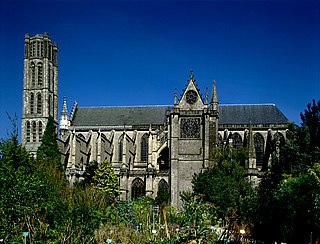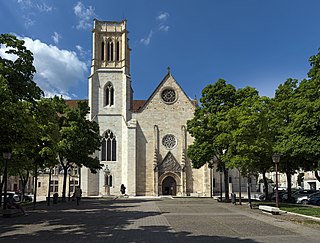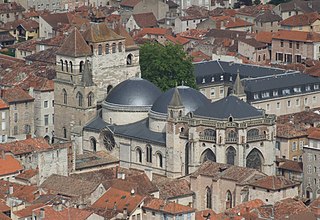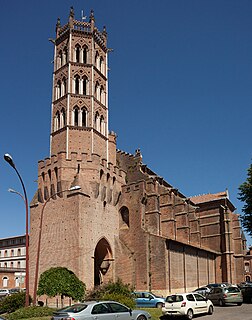Related Research Articles

Jean de Lorraine was the third son of the ruling Duke of Lorraine, and a French cardinal, who was archbishop of Reims (1532–1538), Lyon (1537–1539), and Narbonne (1524–1550), bishop of Metz, and Administrator of the dioceses of Toul, Verdun, Thérouanne, Luçon, Albi, Valence, Nantes and Agen (1538–1550). He was a personal friend, companion, and advisor of King Francis I of France. Jean de Lorraine was the richest prelate in the reign of Francis I, as well as the most flagrant pluralist. He is one of several cardinals known as the Cardinal de Lorraine.

The Diocese of Beauvais, Noyon, and Senlis is a Latin Church ecclesiastical territory or diocese of the Catholic Church in France. The diocese encompasses the department of Oise in the region of Hauts-de-France. The diocese is a suffragan of the metropolitan Archdiocese of Reims. The current bishop is Jacques Benoit-Gonnin, appointed in 2010.

The Roman Catholic Diocese of Limoges is a diocese of the Latin Rite of the Roman Catholic Church in France. The diocese comprises the départments of Haute-Vienne and Creuse. After the Concordat of 1801, the See of Limoges lost twenty-four parishes from the district of Nontron which were annexed to the Diocese of Périgueux, and forty-four from the district of Confolens, transferred to the Diocese of Angoulême; but until 1822 it included the entire ancient Diocese of Tulle, when the latter was reorganized.

The Diocese of Toul was a Roman Catholic diocese seated at Toul in present-day France. It existed from 365 until 1802. From 1048 until 1552, it was also a state of the Holy Roman Empire.

The Diocese of Agen is a Latin Church ecclesiastical territory or diocese of the Catholic Church in France.

The Roman Catholic Diocese of Amiens is a diocese of the Latin Rite of the Roman Catholic Church in France. The diocese comprises the department of Somme, of which the city of Amiens is the capital.

The Roman Catholic Diocese of Cahors is a diocese of the Latin Rite of the Roman Catholic Church in France. The diocese comprises the whole of the department of Lot.

The Diocese of Nancy and Toul is a Latin Church ecclesiastical territory or diocese of the Catholic Church in France. After a considerable political struggle between Louis XV, Louis XVI, and the Dukes of Lorraine, the diocese was erected by Pope Pius VI on 17 December 1777. The Diocese of Nancy is a suffragan diocese in the ecclesiastical province of the metropolitan Archdiocese of Besançon.

The Roman Catholic Diocese of Luçon is a diocese of the Latin Rite of the Roman Catholic Church in France. Its see is Luçon Cathedral in the commune of Luçon. The diocese comprises the department of Vendée. Created in 1317 out of the diocese of Poitiers, its existence was interrupted during the French Revolution, but it was restored in 1821, along with the Bourbon restoration.

The Roman Catholic Diocese of Pamiers, Couserans, and Mirepoix is a diocese of the Latin Rite of the Roman Catholic Church in southern France. The diocese comprises the department of Ariège and is suffragan to the Archdiocese of Toulouse. The diocese of Pamiers is divided into five Deaneries: Pamiers, Foix, Haut-Ariège, Couserans, and Pays-d'Olmes-Mirapoix. The episcopal see is the Cathedral of Saint Antoninus in the city of Pamiers.
Halinard was the Archbishop of Lyon between 1046 and 1052; he also served as abbot of the monastery of Saint-Bénigne in Dijon between 1031 and 1052. He was a counselor of both the Emperor Henry III and Pope Victor II.
Auspicius of Toul was a 5th-century bishop of Toul, the fifth of those recorded, and a saint of the Roman Catholic church. He was also a poet, known for iambic verse based on stress ; this was an innovation of his time. A verse letter of his from around 470 to Arbogast, count of Trier, survives.

Michel Bégon, known as Michel V Bégon or le Grand Bégon was a French ancien regime official. He was intendant de la marine at the port of Rochefort and intendant of the généralité of La Rochelle, as well as a passionate plant collector.
The Sisters of the Christian Doctrine of Nancy (D.C.) is a religious order of the Roman Catholic Church for women, whose primary mission is the teaching and nursing of the poor. Its members place after their names the order's initials, D.C. They are known as the "Vatelottines" in honor of their founder, and also "School Sisters", especially in Germany and Luxembourg, because of their primary mission. They should not be confused with the Spanish order of the Sisters of the Christian Doctrine (Mislata), which was founded in 1880.

Peter of Brixey was Bishop of Toul from 1167 to 1192, and a supporter of the Holy Roman Emperor Frederick Barbarossa in the late twelfth-century phase of the Investiture Controversy, one of the few bishops of Lorraine to do so.
Saint Ursus of Toul, known in French as Saint Ours, was a 5th-century French bishop of Toul and a saint of the Roman Catholic Church with a locally venerated feast day celebrated on 1 March.
Saint Alchas was the third bishop of Toul. He is venerated as a saint by the Roman Catholic Church.
Saint Albaud of Toul, otherwise Aladius or Albin was a 6th-century bishop of Toul. He is venerated as a saint in the Catholic church with a feast day celebrated on 1 March.
Saint Gelsimus of Toul, also known as Saint Celsin, was the fourth bishop of Toul. He is venerated as a saint by the Roman Catholic Church.
Berthold, Bertholde or Bertholdus of Toul was a German Roman Catholic clergyman.